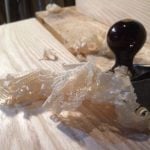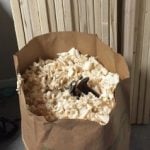Green Red Oak
Welcome! / Forums / General Woodworking Discussions / Wood and Wood Preparation / Green Red Oak
Tagged: Green lumber, mallet, preserving
- This topic has 13 replies, 7 voices, and was last updated 7 years, 8 months ago by
jeffpolaski.
-
AuthorPosts
-
10 September 2016 at 8:58 pm #140043
Hey gang, looking for some insights.
I’m planning my first project to be a proper mallet. Of course this requires a thick piece of stock. Almost everything I can find that’s 4″ thick, is a turning blank. The exceptions are sources that offer larger dimension lumber in board or flitch quantities for mucho dinero.
The turning blanks are cheap enough, but they’re all green.
I know that there are times and places where wood is worked green, but don’t have a sense whether a mallet of Red Oak would be one of those times and laces.
My understanding is that thick pieces are hard to dry without cracking, especially in a kiln, because they dry from the outside in. Therefore, the outside dries and shrinks while the inside is still wet and firm, resulting in cracks.
Does anyone have a clue whether I can use green Oak for mallet building?
Thanks
Rick G

I did a quick search and found at least one blog where green wood was used, the owner felt like it tightened up on the handle as it dried. One of my timber frame books makes reference to using fresh cut wood from the build site for large mallets used there. It does go on to state the typically split, mind you these are 8″ round plus heads.
I would give it a try.BrianJ

I actually use those turning blanks for the mallets I’ve made recently but the ones I got certainly weren’t green. I got them at Woodcraft (they had an awesome sale on several hardwood varieties for $8 (3″x3″x6″). I made a big one out of padauk and then a couple of smaller ones (because I cut the blanks in half) out of osage orange and mora. I just love seeing the grain come out as I create. I’m making another larger one now out of bloodwood just for kicks. Suddenly I have 6 mallets but only really need 1-2!
Separately, I love the way padauk smells when working with it–it’s like chocolate. Love the stuff though it turns everything red!
11 September 2016 at 4:36 am #140051Dbockel2,
Ok, I have to ask about your name… Are you Dave, or Dan, or something starting with a “D”, Bockel?. Or is your handle a pun?
Moving right along, I was going to ask where your located in Ontario (We have relatives in Toronto) until I realized that Ontario stretches from almost Montana to Vermont.
As to turning stock, I hope I’m wrong, but Woodcraft says nothing about kiln or air drying for their turning stock. Re their other lumber they reference kiln drying. This doesn’t imply no drying has occurred, but suggests that it’s just air drying based on how long it’s sat in the cutter’s, possibly a wholesaler’s, and Woodcrafts stock.
Their spalted maple blanks look nice, wonder if I should try one?
Rick G

lol. it’s David but I get the debacle joke more than enough that it stopped being funny decades ago! I’m not that creative!
I honestly don’t know the answer to your follow-up comment on the Woodcraft wood. I just assumed it was dried (but I certainly don’t know the methods or where they even get some of their stuff sometimes). All I know is that he first thing I do is scrape all of that god awful wax off and then get to work with it.
 11 September 2016 at 6:11 pm #140058
11 September 2016 at 6:11 pm #140058I think you would find the spalted maple too soft for a mallet. The spalting is caused by the wood starting to decompose. I’ve used spalted maple for turning and the hardness of the wood varies quite a bit between the spalted and sound parts of the blank.
12 September 2016 at 5:20 am #140073Thanks Peter,
Great info based on firsthand knowledge.
Back to Red Oak
RickG12 September 2016 at 5:32 am #140074David,
Well I’m glad I didn’t assume. The favorite play against my name was gag-a-moose.
Re. The wax – I suspect that’s evidence that the wood is not fully dry. Once it’s seasoned, the wax shouldn’t be necessary. Yes moisture can go in and out, but that should only be a small adjustment between its delivered water content and the equilibrium level of same in its new environment.
I’m going to try build one mallet with such unseasoned stock to see what happens. Meanwhile, there’s a nearby mill and kiln for reclaimed urban trees. I’m going to see what they can do for me, possibly even cut offs. Maybe I can find nod something thick, kiln dried and affordable.
Cheers
Rick G
12 September 2016 at 4:35 pm #140087I’m a little late to the party, but I ordered from turningblanks.net before and had good luck. Some stock is green and some is dried, but it is all clearly labelled on the site.
17 October 2016 at 5:07 pm #141509I used a piece of cherry fire wood I have laying around for a mallet head. I believe it was less than a year since I cut it down and it had been setting on my firewood pile. If you know someone that burns wood, they might be willing to give you a piece or two.
Another option (I know here in the US) is to keep your eye on some downed tree from storms. A lot of times they will cut them enough to get them off the roads and let them rot. Most of the time if you ask the land owner they will give it to you. I find a lot of people like people that make things with their hands.
I also find it a nice gesture to make a spoon or something and give it to the person as a gift for the free wood.
-
This reply was modified 7 years, 9 months ago by
Thomas Angle.
19 October 2016 at 2:50 pm #141628I’m currently looking for a used oak pallet. Lots of wood in that.
24 November 2016 at 6:50 pm #142668Well, I’ve got maybe a 1/4 cord of large Red Oak branches (18 inches diameter) that fell on my garage roof a month ago. Someone else’s tree, but I paid for the cleanup and roof repair, so those sections of thick wood are mine. What do I do with them? I’m thinking carving (starting with a chainsaw).
Do I take the bark off? I can seal the ends of the sections. If I take the bark off, so I seal the sapwood — or— do I also take the sapwood off and then what do I do with the heartwood? They aren’t long enough to make boards (8″ to 18″ long), but that wood inside looks mighty good. It would be a shame to dry it for burning.
The wood hasn’t started to check yet (like last year’s Maple and Cherry, not matter how much sealer I used), so there’s an opportunity here before the snow flies in Philadelphia.
Words of experience, anyone?
-
This reply was modified 7 years, 9 months ago by
-
AuthorPosts
- You must be logged in to reply to this topic.
